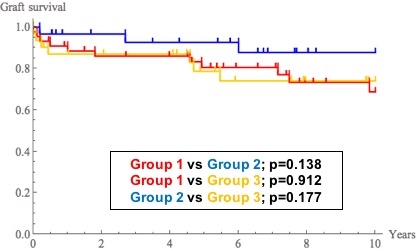10-Year Outcomes of Renal Transplantation from Circulatory Death Donors with Increased Terminal Creatinine
Surgery III, Tokyo Women's Medical University, Tokyo, Japan.
Meeting: 2018 American Transplant Congress
Abstract number: C59
Keywords: Donors, Graft survival, Kidney transplantation, marginal, non-heart-beating
Session Information
Session Name: Poster Session C: Kidney Donor Selection / Management Issues
Session Type: Poster Session
Date: Monday, June 4, 2018
Session Time: 6:00pm-7:00pm
 Presentation Time: 6:00pm-7:00pm
Presentation Time: 6:00pm-7:00pm
Location: Hall 4EF
Background: To alleviate chronic renal graft shortages in Japan, donation after circulatory death (DCD) is an increasingly used organ resource. Organs from DCD donors with progressively increased terminal creatinine (t-Cr) levels are frequently used, but the effects of this condition on renal transplantation (RTx) remain unclear.
Methods: From 1996 to 2017, 105 RTx from DCD donors were performed in our department. Recipients were grouped according to the t-Cr (in mg/dl) of donors: group 1, t-Cr < 1.5 (N=44); group 2, 1.5 ≤ t-Cr < 3.0 (N=30); and group 3, t-Cr ≥ 3.0 (N=31). We analyzed the 10-year outcomes of RTx from DCD donors retrospectively in terms of donors' terminal renal function. Survival for patients and grafts were calculated using Kaplan-Meier estimation. Differences in survival among each group were assessed using the log-rank test. Factors affecting graft survival for 10 years were analyzed using univariate and multivariate Cox proportional hazard regression models.
Results: The respective mean donor t-Cr in groups 1, 2, and 3 were 0.77 ± 0.26, 2.01 ± 0.37, and 6.67 ± 3.76. The respective death-censored graft survival rates (%) in groups 1, 2, and 3 were 90.8, 96.6, and 87.0 at 1 year, 80.5, 92.6, and 78.7 at 5 years, and 68.7, 87.7, and 74.1 at 10 years after RTx.  Group 1 exhibited lower incidence of delayed graft function than either group 2 or group 3 (75.0% vs 86.6% and 90.3%; P=0.1467). Nevertheless, no significant difference was found between groups for several measures: Cr levels 1 month after RTx (P=0.2004) and lowest Cr levels throughout the observation period (P=0.2357), prevalence of biopsy-proven acute rejection (P=0.2814), and graft survival (P=0.9127; group 1 vs group 3 and P=0.1775; group 2 vs group 3). Cox proportional hazard regression showed that donor age (P=0.015), cerebrovascular event (P=0.016), terminal urine output (P=0.035), and history of hypertension (P=0.024) were significantly associated with graft survival.
Group 1 exhibited lower incidence of delayed graft function than either group 2 or group 3 (75.0% vs 86.6% and 90.3%; P=0.1467). Nevertheless, no significant difference was found between groups for several measures: Cr levels 1 month after RTx (P=0.2004) and lowest Cr levels throughout the observation period (P=0.2357), prevalence of biopsy-proven acute rejection (P=0.2814), and graft survival (P=0.9127; group 1 vs group 3 and P=0.1775; group 2 vs group 3). Cox proportional hazard regression showed that donor age (P=0.015), cerebrovascular event (P=0.016), terminal urine output (P=0.035), and history of hypertension (P=0.024) were significantly associated with graft survival.
Conclusions: These results suggest that kidneys from DCD donors with progressively increased t-Cr can be used safely with promising long-term outcomes.
CITATION INFORMATION: Tomita Y., Iwadoh K., Nakajima I., Fuchinoue S. 10-Year Outcomes of Renal Transplantation from Circulatory Death Donors with Increased Terminal Creatinine Am J Transplant. 2017;17 (suppl 3).
To cite this abstract in AMA style:
Tomita Y, Iwadoh K, Nakajima I, Fuchinoue S. 10-Year Outcomes of Renal Transplantation from Circulatory Death Donors with Increased Terminal Creatinine [abstract]. https://atcmeetingabstracts.com/abstract/10-year-outcomes-of-renal-transplantation-from-circulatory-death-donors-with-increased-terminal-creatinine/. Accessed December 23, 2025.« Back to 2018 American Transplant Congress
